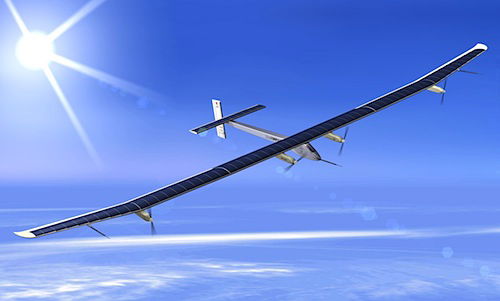Solar Impulse – the first aircraft ever to be designed to fly around the world using only solar PV power – took off on its planned five-month journey of 22,000 miles from Abu Dhabi in the United Arab Emirates. It is now above China and is being helped on its way by ABB. By James Hunt:
Solar Impulse is a revolutionary carbon fibre aircraft boasting the wingspan of a Boeing 747 (63.4m / 208 ft) and the weight of a small car (1,600kg / 3,527 lb), yet is zero fuel (albeit rather slow).
Voltimum founder member company ABB is supporting Solar Impulse in its daring endeavour with work on key technologies - such as power electronics - for mutual benefit.
There’s a surprising symbiosis for two organisations that are outwardly so different – not least in size. Both are Swiss-based pioneers of cutting-edge clean energy technologies and both are striving to address the world’s energy challenges through groundbreaking technological innovation.
Solar Impulse shows what is possible when one organisation is willing to venture beyond the boundaries of the conventional wisdom, while ABB shows how breakthrough innovation can be transformed into technologies and solutions for, it says, “a better world”.
The parallels don’t end there, says ABB. Both firms are focused on solving similar challenges. Each has made significant contributions to knowledge of how renewable energy can be more efficiently transformed into electricity, and how that electricity can be deployed in the most efficient way possible. Moreover, both are working on novel and creative ways of storing energy to improve the reliability and stability of electrical systems.
ABB is a global leader in renewables, sustainable transportation and energy efficiency. The company is the world’s second-largest supplier of solar inverters and one of the largest suppliers to the wind-power industry. It is also a leader in integrating renewables efficiently and reliably into power grids.
In March last year, the company announced that it would be building the world’s largest network of new-generation, fast chargers for electric vehicles (EVs) in China. Furthermore, its installed base of drives for motors alone saved around 400 TWh in electricity in 2013, equivalent to the annual power consumption of 100 million European households.
So ABB is well placed to help a project like Solar Impulse and believes that by joining forces, the two organisations will be able to strengthen the case for renewables and to demonstrate that economic growth, progress and quality of life can be maintained and improved without consuming unsustainable amounts of energy and polluting the environment.
The technology
Solar Impulse is the result of seven years of intense work, calculations, simulations and tests by a team of about 80 people and 100 partners and advisors. A plane so big yet so light has never been built before.
The 17,248 monocrystalline silicon solar cells (which are a mere 135 micron thick) built into the wings, fuselage and horizontal tail plane, provide four electric motors with renewable energy. By day, the solar cells – which can collect up to 340 kWh of solar energy each day - recharge the 400 kg / 881 lb lithium batteries, which allow the plane to fly at night. The energy density of these batteries is a high 4 x 260 Wh/kg.
The four brushless sensorless electric motors each generate 17HP (around 13kW) and are mounted below the wings. Fitted with a reduction gear limiting the rotation speed of the 4m diameter, two-bladed propellers to 525 rev/min, the entire system is an astonishing 94% efficient.
Solar Impulse required the development of new materials and new construction methods. There are new battery electrolytes that allow the energy density of the batteries to be increased, nanotechnologies are being used, and there are carbon fibres in the structure that are lighter than any previously seen.
The batteries are insulated by high-density foam and mounted in the four engine nacelles, with a system to control charging thresholds and temperature. Their total mass amounts to 633 kg, or just over a quarter of the aircraft’s all-up weight.
To save energy, the aircraft climbs to 8,500m during the day and descents to 1,500m at night.
A dream
“It was my dream to have ABB as technology partner of Solar Impulse,” said Bertrand Piccard, initiator and chairman of Solar Impulse. “We have the same goal of improving the world by using energy more efficiently and conserving natural resources.”
Commented ABB CEO Ulrich Spiesshofer: “This partnership brings together two Swiss-based global leaders that are passionate about pushing the boundaries of technology and innovation to achieve a better world.
“We believe in Bertrand’s vision, and we are convinced that by pioneering innovative technologies we will be able to decouple economic growth from energy consumption and environmental impact,” he said.
